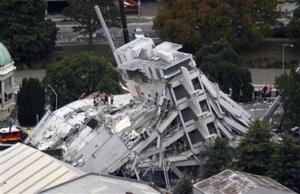DisastersBuilding design lessons from the Christchurch earthquake
A leading infrastructure expert believes an assessment needs to be made of the level of “very rare” earthquake that needs to be considered in structural design, perhaps one with a 10,000 year return period or higher, rather than the 500 year return period that is commonly adopted for many buildings in Australia

Experts maintain design should accomodate a 10,000 year return // Source: jbkse.com
A leading infrastructure expert believes an assessment needs to be made of the level of “very rare” earthquake that needs to be considered in structural design, perhaps one with a 10,000 year return period or higher, rather than the 500 year return period that is commonly adopted for many buildings in Australia.
Owing to the vulnerable nature some current buildings, if such an earthquake did occur, it would be likely to cause many buildings to collapse or to be severely damaged, and hence the potential to result in a large number of fatalities.
A University of Melbourne release reports that Dr. Helen Goldsworthy from the Department of Infrastructure Engineering at the University of Melbourne was part of the recovery effort in Christchurch on behalf of the Australian Earthquake Engineering Society (AEES) two weeks after the devastating earthquake.
Speaking at a conference, her keynote paper, titled “Lessons from the February 22nd Christchurch Earthquake,” highlights the damage observed in reinforced concrete buildings, the effects of liquefaction, and also of the large vertical accelerations generated by this near-field event.
Australia, although in a region of low to moderate seismicity, is one of the most active intraplate regions in the world. Most of the Australian capital cities have faults in their vicinity that are capable of generating damaging shallow earthquakes, and it is expected that a magnitude six or higher earthquake is likely to strike one of the Australian capital cities every few thousand years.
This has been recognized by the international insurance industry for some time. For example, Sydney has been assessed as having one of the highest earthquake insurance risks in the world. Many of the types of construction present in Sydney, especially the older ones, are vulnerable to earthquakes.
Dr. Goldsworthy makes several key observations about the Christchurch experience. “Any major earthquake event leads to a reassessment of design philosophies, and the Christchurch earthquake is no exception to that. The 6.3 magnitude Christchurch earthquake approximately represented a 2,500 year event for that city which is in a region that is influenced by continental plate boundary movements and hence is expected to have more frequent high level earthquakes than cities in Australia,” she said.
“The most important lesson for Australia is that structural engineers need to be educated to design buildings so that they are likely to withstand a very rare earthquake without collapse. The robustness clause in the loading code AS/NZS 1170.0 is intended to ensure that the damage caused by an event is not disproportionate to the magnitude of that event. The question here is what type of damage would the structural engineering community view as appropriate for a very rare earthquake event in Australia, for example one with a 10,000 year return period? It is my opinion that “prevention of collapse” under this level of event is the minimum performance that would be considered acceptable.” Dr. Goldsworthy said.
